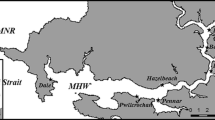Summary
The possible routes which could have been followed byD. tigrina in the course of its immigration in the Netherlands are discussed (Fig. 1). The species is almost restricted to the larger, eutrophic waters and is found usually under stones. The absence of species in smaller waters, such as ditches, could be explained by an interaction of various factors. The succesful immigration ofD. tigrina in the larger waters is partly due to the very catholic and opportunistic manner of feeding, by which the species can co-exist withD. polychroa. The distribution pattern and habitat ofD. tigrina in the Netherlands is similar to that ofPlanaria torva (this species is, however, more widely distributed in the Netherlands). The two species probably have solved the problem of co-existing withD. polychroa in a different way. The thermal pollution of today is favourable for a thermophilous species, such asD. tigrina.
Similar content being viewed by others
References
BALL, I.R., T.B. REYNOLDSON and T. WARWICK, 1969. The taxonomy, habitat and distribution of the freshwater tricladPlanaria torva (Platyhelminthes: Turbellaria) in Britain. J. Zool., Lond., 157: 99–123.
BERGE HENEGOUWEN, A.L. VAN and G. VAN DER VELDE, 1975. De waarde van de Kagerplassen, vastgesteld aan de hand van de macrofauna, in het bijzonder van de oevers. Zool. Bijdr., Leiden, 17 (Bijdr. Faun. Nederland, III): 4–21.
BODDINGTON, M.J. and D.F. METTRICK, 1974. The distribution, abundance, feeding habitats, and population biology of the immigrant tricladDugesia polychroa (Platyhelminthes: Turbellaria) in Toronto Harbour. J. Anim. Ecol., 43 (3): 681–699.
DAHM, A.G., 1958. Taxonomy and ecology of five groups in the family Planariidae (Turbellaria Tricladida Paldicola). Malmö: 1–241.
GOURBAULT, N., 1969. Expansion deDugesia tigrina (Girard) planaire Américaine introduite en Europe. Annal. Limnol., 5 (1): 3–7.
HARTOG, C. DEN, 1959.Dugesia tigrina, an immigrant triclad in the Netherlands. Biol. Jaarb. Dodonaea, 27: 68–72.
HARTOG, C. DEN, 1962. De Nederlandse platwormen (Tricladida). Wetenschappelijke Mededelingen K.N.N.V., 42: 1–40.
HARTOG, C. DEN, 1967. De verspreiding van de platwormDugesia tigrina in Nederland. Natura, 64 (4): 81–82.
HARTOG, C. DEN and A.S. TULP, 1960. Hydrobiologische waarnemingen in Friesland I. De Levende Natuur, 63: 109–120.
HARTOG, C. DEN and G. VAN DER VELDE, 1973. Systematische notities over de Nederlandse platwormen (Tricladida). De Levende Natuur, 76: 41–45.
HEUSS, K., 1971. Neufunde vonDugesia tigrina (Girard) Turbell., Tricladida) im Gebiet der Niederrheines und der unteren Maas. Decheniana, 123 (1/2): 53–57.
PICKAVANCE, J.R., 1971a. The diet of the immigrant planarianDugesia tigrina (Girard) I. Feeding in the laboratory. J. Anim. Ecol., 40 (3): 623–636.
PICKAVANCE, J.R., 1971b. The diet of the immigrant planarianDugesia tigrina (Girard) II. Food in the wild and comparision with some British species. J. Anim. Ecol., 40 (3): 637–650.
REYNOLDSON, T.B., 1974. Ecological separation in British Triclads (Turbellaria) with a comment on two American species. Chapter 11 in: N.W. Riser and M.P. Morse (eds.): The Biology of Turbellaria: 213–228. (New York).
REYNOLDSON, T.B., 1975. Food overlap of lake-dwelling triclads in the field. J. Anim. Ecol., 44 (1): 245–250.
REYNOLDSON, T.B. and J.O. YOUNG, 1963. The food of four species of lakedwelling triclads. J. Anim. Ecol., 32: 175–191.
REYNOLDSON, T.B., J.O. YOUNG and M.C. TAYLOR, 1965. The effect of temperature on the life-cycle of four species of lake-dwelling triclads. J. Anim. Ecol., 34: 23–43.
REYNOLDSON, T.B. and R.W. DAVIES, 1970. Food niche and co-existence in lake-dwelling triclads. J. Anim. Ecol., 39: 599–617.
RUSSIER-DELOLME, R., 1972. Coefficients thermiques et écologie de quelques Planaires d'eau douce. 6.Dugesia tigrina. Annls. Limnol., 8 (2): 119–140.
TAX, M. and T. NEVE, 1975. Twee vindplaatsen van de platwormPhagocata vitta in Nederland. De Levende Natuur, 78: 181–184.
TULP, A.S., 1967. Hydrobiologische notities over de Grote Wielen. De Levende Natuur, 74: 109–115.
VELDE, G. VAN DER, 1973. Verzoek: verspreiding van triclade platwormen in Nederland. Hydrobiol. Bull, Amsterdam, 7 (1): 44–46.
VLIES, A.W. VAN DER, 1971. Inventarisatie van de macrofauna in het stroomgebied van de Kromme Rijn in verband met de waterverontreiniging en de vergelijking van een aantal methoden voor de bemonstering van de macrofauna. RIN-verslag: 1–46. (Unpublished report).
YOUNG, J.O., 1972. The Turbellaria of some Friesland lakes with incidental records of Gasteropoda and Hirudinea. Zool. Bijdr., Leiden, 13 (Bijdr. Faun. Nederland, II): 59–70.
Author information
Authors and Affiliations
Rights and permissions
About this article
Cite this article
Van Der Velde, G. The immigrant triclad flatwormDugesia tigrina (Girard) (Plathelminthes, Turbellaria). Range-extension and ecological position in The Netherlands. Hydrobiological Bulletin 9, 123–130 (1975). https://doi.org/10.1007/BF02263331
Issue Date:
DOI: https://doi.org/10.1007/BF02263331



